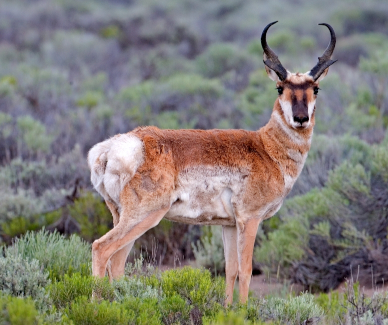The habitat of the prong-horn antelope (Antelocapra Americana, called "le cabris” by the Canadian, and “the goat” by the unpoetic mountain man) extends from the plains west of the Missouri to the Pacific Ocean; it is also abundant on Minnesota and on the banks of the Red River; its southern limit is Northern Mexico, whence it ranges to 53° N. lat. on the Saskatchewan.  It is about the size of a small deer, the male weighing 65 lbs. in good condition. The coat is coarse and wiry, yellow dun on the back, with dull white under the belly, and the tanned skin is worth three dollars. It is at once the fleetest and the wariest animal on the prairies, and its sense of hearing as acute as its power of smell. The best time for "still hunting” (i.e., stalking) is at early dawn, when the little herds of four or five are busy grazing. They disappear during the midday heats of summer, and in the evening, as in India and Arabia, they are wild and wary. They assemble in larger bodies near the Rocky Mountains, where pasturage—not sage, which taints the meat-abounds, and the Indian savages kill them by surrounds, especially in winter, when the flesh is fattest. White men usually stalk them. During the migration season few are seen near the road; at other times they are often sighted. They are gifted, like the hippopotamus, with a truly feminine curiosity; they will stand for minutes to stare at a red wagon-bed, and, despite their extreme wariness, they will often approach, within shot, a scarlet kerchief tied to a stick, or any similar decoy. In manner they much resemble the Eastern gazelle. When the herd is disturbed, the most timid moves off first, followed by the rest; the walk gradually increases from a slow trot to a bounding gallop. At times they halt, one by one, and turn to gaze, but they presently resume flight, till they reach some prominent place where their keen vision can command the surrounding country. When well roused, they are thoroughly on the alert; the hunter will often find that, though he has moved toward them silently, up the wind and under cover, they have suspected sinister intentions and have shifted ground.
It is about the size of a small deer, the male weighing 65 lbs. in good condition. The coat is coarse and wiry, yellow dun on the back, with dull white under the belly, and the tanned skin is worth three dollars. It is at once the fleetest and the wariest animal on the prairies, and its sense of hearing as acute as its power of smell. The best time for "still hunting” (i.e., stalking) is at early dawn, when the little herds of four or five are busy grazing. They disappear during the midday heats of summer, and in the evening, as in India and Arabia, they are wild and wary. They assemble in larger bodies near the Rocky Mountains, where pasturage—not sage, which taints the meat-abounds, and the Indian savages kill them by surrounds, especially in winter, when the flesh is fattest. White men usually stalk them. During the migration season few are seen near the road; at other times they are often sighted. They are gifted, like the hippopotamus, with a truly feminine curiosity; they will stand for minutes to stare at a red wagon-bed, and, despite their extreme wariness, they will often approach, within shot, a scarlet kerchief tied to a stick, or any similar decoy. In manner they much resemble the Eastern gazelle. When the herd is disturbed, the most timid moves off first, followed by the rest; the walk gradually increases from a slow trot to a bounding gallop. At times they halt, one by one, and turn to gaze, but they presently resume flight, till they reach some prominent place where their keen vision can command the surrounding country. When well roused, they are thoroughly on the alert; the hunter will often find that, though he has moved toward them silently, up the wind and under cover, they have suspected sinister intentions and have shifted ground.
Besides the antelope, there are three species of deer in the regions east of the Rocky Mountains. Perhaps the most common is the red deer of the Eastern States (Cervus Virginianus; le chevreuil): it extends almost throughout the length of the continent, and is seemingly independent of altitude as of latitude. The venison is not considered equal to that of the antelope; travelers, however, kill off the deer to save butchers' bills, so that it is now seldom glimpsed" from the line of route. The black-tailed or long-eared deer (Cervus macrotis) is confined to the higher ground; it has similar habits to the red variety, and is hunted in the same way. The long-tailed, or jumping deer (Cervus leucrurus, vulgarly called the roebuck), affects, like the black-tailed, the Rocky Mountains. The elk (Cervus Canadensis) is found in parts of Utah Territory and forty miles north of the mail-road, near the Wind-River Mountains - a perfect paradise for sportsmen. It is noble shooting, but poor eating as the Indian sambar. The moose (Cervus Alces), the giant of the deer kind, sometimes rising seventeen hands high, and weighing 1200 lbs., is an inhabitant of higher latitudes—Nova Scotia, Canada, Maine, and other parts of New England.